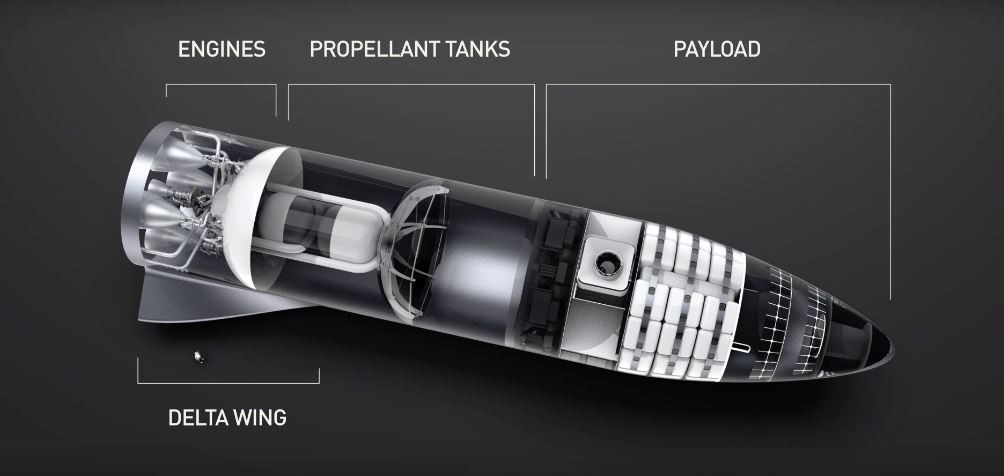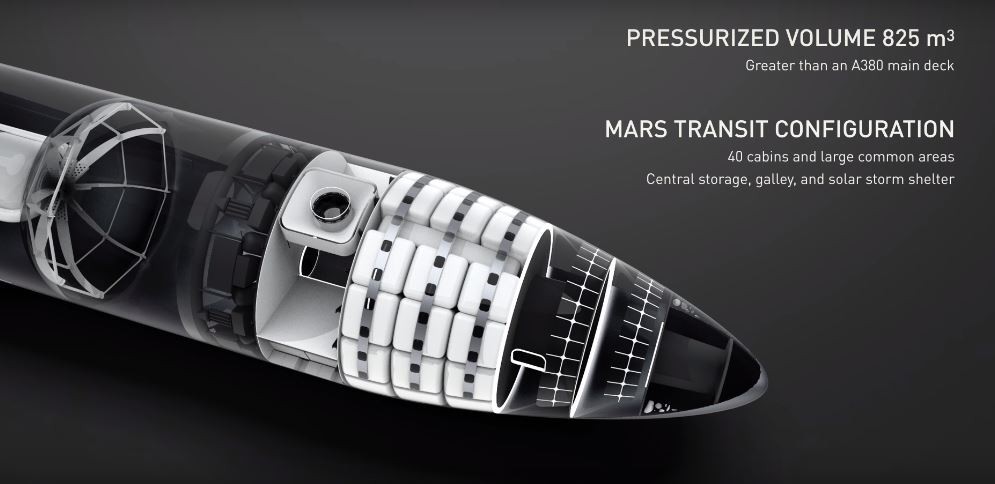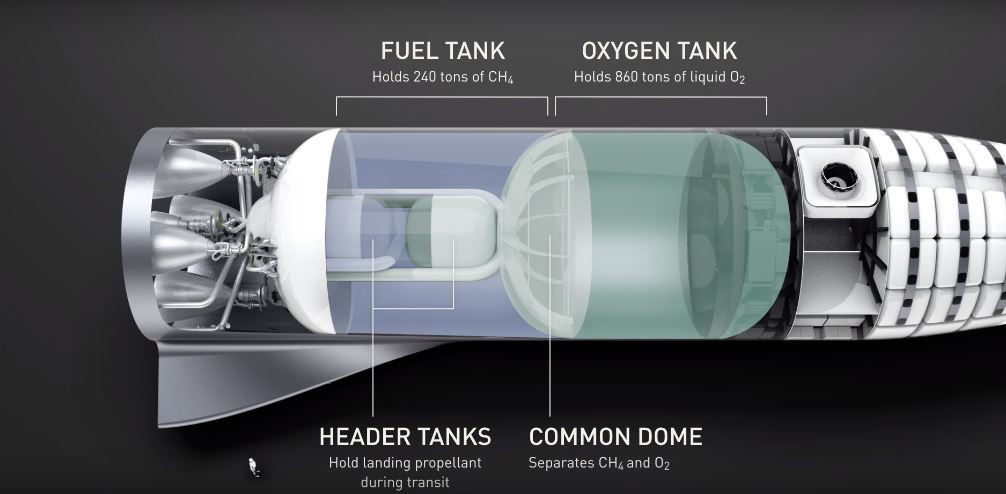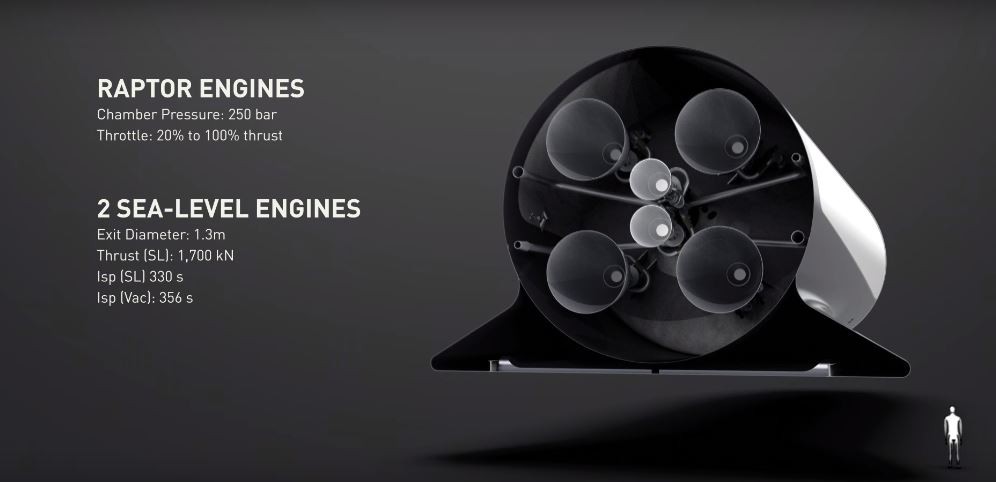The SpaceX Big Falcon Rocket (BFR) and Starship
The Big Falcon Rocket, commonly known as BFR, is the latest prototype which SpaceX is working on. Elon Musk’s ultimate ambition is to be able to send astronauts to Mars, so he’ll need a brute of a rocket to be able to get there, and hopefully, back again.
At the time of writing, SpaceX has two main rockets which it uses to send its cargo, satellites and eventually, astronauts into space. Falcon 9 is its ‘everyday’, standard operation rocket. This can be used to put most kinds of payloads into any kind of Earth orbit. Meanwhile, its more powerful brother, the Falcon Heavy can be used should a more heavy duty launch be required. This could be because the proposed payload is extra heavy, or because the rocket needs to go further, say to the Moon or beyond.
BFR is intended to take on both these functions and more. In fact, it is planned to be able to handle just about every mission currently envisaged by the company, so it will have to be exceedingly powerful and flexible too. It’s going to need to be a pretty special rocket, and as we shall see – it is.

History and Development of the Big Falcon Rocket
First news of plans for the development of a new kind of rocket came as far back as 2012. This was barely two years after the inaugural flight of Falcon 9 and long before Falcon Heavy ever left the launch pad. There were few details at that stage, other than that this new design was intended to have capabilities far beyond those of anything currently in production.
By 2015, Musk was dropping more than a few hints that this new rocket would be more than just an upgrade, but would in fact be something more ambitious altogether. It was to be a rocket which was intended to enable the colonisation of Mars.
The media, aeronautical experts and pundits alike were not sure what to make of these announcements. The PR hungry mogul is renowned for his grandiose statements. In fact, as more details emerged of this innovative new concept, it became clear that if anything he was understating just how revolutionary his proposals were.
A media presentation in September 2016 sketched out his vision of how this Mars colony building rocket system might work, but it was short on details. It seemed to be aimed more at attracting outside partners and possible financial investment providing a detailed explanation.
In 2017, Musk finally began to show his hand. His new rocket, which at this point did not even have an established name, was to be truly revolutionary. Not only would it be powered by engines of a design type which had never successfully reached space before, but the engines would be fuelled by a propellant which had never been used in a recognised rocket before either…

Construction and Characteristics
Construction and Characteristics
BFR will be a two stage rocket. It will consist of a first stage called the Super Heavy, which will provide the thrust to take the rocket from the launch pad into space, and a second stage called the Starship. This will be capable of being used in any of four different configurations depending on the purpose of the mission. Both sections are intended to be re-usable, being capable of returning to Earth for refurbishment and re-used for future missions. The total height of the rocket will be 118m, which is taller than Apollo’s Saturn V.
Both stages will be powered by a revolutionary new technology: Raptor engines. Now this is not the place for a detailed technical description of how a rocket works. There are plenty of explanations available via Google or YouTube if you have a brain for technological complexity and high level engineering. For our purposes, suffice it to say that the Raptor is a new concept of engine which has never got past the testing stage before, never mind attempting to reach space.
Yet it is not only the design and construction which is radical and pioneering. Raptor engines burn a hitherto unused type of propellant: methane. Again, the reasons for using this novel fuel are somewhat technical, but basically it provides a useful compromise between the low density and low boiling point of hydrogen and the high density and higher boiling point of rocket grade kerosene. Looking further ahead, methane also has the advantage of it being theoretically possible to manufacture on Mars.
The new Raptor engine was first test fired in September 2016, although this was a prototype which was a third of the size of the planned production engine. Raptor has subsequently undergone over forty separate tests, amounting to over 20 minutes of firing.
Having been consistently tested, the focus has turned to manufacturing more full sized rockets. At the time of writing, there are already six full sized prototype engines, which are currently under testing. The first flight test is expected in 2020.
The first stage, Super Heavy rocket will contain 31 of these Raptor engines. It will be 63 metres (207ft) tall and 28.3 metres (94.3ft) in circumference. Fully fuelled at lift-off, it is expected to weigh over 3 million kg (over 6.75 million lb). And remember, this is just the Super Heavy booster: the Starship and cargo it will be carrying will add a further 1.3 million kg (3 million lb), giving a total weight for the BFR of around 4.4 million kg (9.7 million lb).The total thrust available to the rocket at take-off will be just short of 14 million lb force.
The second stage is the Starship. This will be 55 metres long and powered by seven Raptor engines. It will have landing pads for use on its return to Earth. The ship will contain two cargo bays: a forward pressurised hold, offering more than 1000m3 in volume (35,000 cubic feet), and a rear unpressurised cargo hold with a further 88m3 (3,100 cubic feet) of potential space. The maximum potential payload will be up to 150,000kg (330,000lb).
From a payload point of view, this means that it will offer by far the greatest volume and weight of carrying capacity of any rocket available today or in the past. The BFR offers almost three times the payload potential of its predecessor the Falcon Heavy, and even more than the previous record holder, NASA’s Saturn V.
Better still, it will be re-usable. This will enable it to deliver its cargo at a very low comparative cost. Because its competitors are mostly one-off launches which result in the destruction of the rocket, the BFR offers the lowest marginal cost per launch of any of its rivals, either currently in use or now retired. This is despite the fact that it also has far greater capacity than any of them.
Yet perhaps the most impressive feature of this spacecraft will be its flexibility. It will be capable of being used in any of at least four different configurations:
- Cargo carrying spaceship – in this format, both pressurised and unpressurised sections can be used to carry provisions, equipment and other resources into space.
- Passenger carrying spaceship – the forward pressurised cabin can be used as a crew ship, used to launch astronauts and commercial passengers into Earth orbit and beyond. The maximum number of passengers it can carry will depend on the type of journey and its purpose. But with 1,000m3 of pressurised cabin capacity to play with, it is designed to be able to carry up to a hundred passengers, over lunar and even interplanetary distances, such as to Mars.
- Satellite delivery spacecraft – the Starship will be fitted with a large cargo bay door. This means that it will be able to be used a bit like the now retired Space Shuttle: to put large payloads into orbit, but also to repair existing malfunctioning satellites or return them to Earth.
- Fuel Tanker – in this configuration, the Starship will carry propellant only. It would be used to refuel rockets in space, or possibly to ferry fuel to distant space stations or colonies.

What Will The Big Falcon Rocket Be Used For?
The power and ground breaking nature of this rocket is certainly impressive, but what really stands out about this launch system is its flexibility. What can this rocket be used for? Just about everything.
Aside from the flexibility offered by its four alternative Starship configurations, the BFR can be used for a vast range of purposes, missions and distances.
The key to the amazing versatility of the rocket is its ability to be used as a fuel tanker. This means that a rocket can be launched into low Earth orbit (LEO) and then refuelled. This would then give the already launched Super Heavy first stage booster a full tank of fuel, enabling it to reach far greater distances. Crucially for Elon Musk’s ultimate ambitions, this could include distances as far as Mars. It will certainly be able to supply provisions, equipment and people to potential lunar orbiting space stations and Moon bases with ease.
But perhaps the most startling ability of this rocket will be its potential for revolutionising travel back on Earth. By travelling up into space and back to earth in one parabolic loop, the BFR will be able to deliver passengers from one side of the planet to the other in well under an hour.
London to New York could potentially take less than half an hour, London to Los Angeles would be just over 30 minutes while London to Sydney could take as little as 50 minutes. And with around 100 seats available on each flight, the economics of this kind of service may bring ticket prices within the range of many. In the long term, prices may well settle around the future equivalent of what people would expect to pay today for a long haul business class or first class flight.

Outlook for BFR and Starship
This revolutionary rocket has the potential to completely rewrite the textbooks on rocket design. This may well be fantastic news for rocket scientists and engineers in general.
For the rest of us, its practical implications are astounding. The BFR could make lunar bases and colonies a realistic prospect for the first time. It could also expand the range of human exploration and habitation beyond the Moon to Mars and even into interplanetary space.
And even if the potential for a Star Trek style voyage across the depths of space leaves you unimpressed, surely even the most sceptical will applaud the prospect of being able to travel across the globe in less than an hour. If things go according to plan, we should be able to expect such flights to be commonplace within a decade.
